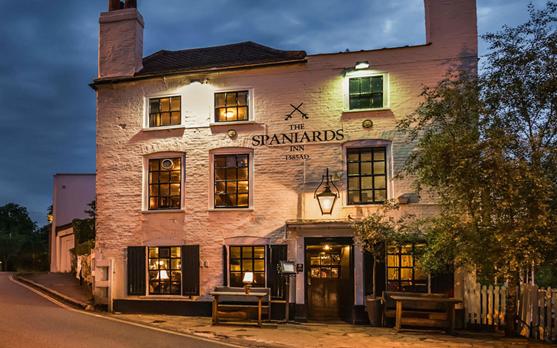
Salty Sam’s Fun Blog for Children
Number 318
Dick Turpin
Hello Everyone

l thought this week, l would tell you a story. Not maybe a story to be read at bed time if you don’t like scary stories, but it is an interesting one.
lt is a very strange thing, l have noticed, that sometimes, horrible people turn into romantic figures once they become figures in history.
Over time, accounts of what really happened can change.
Dick Turpin is one such figure; glamourized in popular fiction since his death, his story has been turned into something quite different from the truth.
Everyone has heard of the dashing highwayman’s overnight flight from London to York, fleeing from justice on his horse Black Bess.
But this didn’t actually happen.
lt seems in reality he was a cruel and vicious person, and he certainly didn’t ride from London to York in one night.
The real story of his life is not totally clear but very intriguing nevertheless.
lt goes something like this…
He was born in Hempstead, Essex in 1705. His father was John Turpin, a farmer, butcher and landlord of the Bluebell lnn.
Richard Turpin started his working life as a butcher’s boy in Whitechapel, now part of London, it was a village on the outskirts at the time, and on completing his apprenticeship he got married and opened his own shop.
lt seems he thought it a good idea to procure (get) free stock for his shop by turning to a life of petty crime; stealing deer, cattle and sheep.
On one occasion he was caught in the act of stealing two oxen. Their bodies were found at his shop and then their hides were later found and identified. Turpin managed to escape from the constables through the back window of his house and his wife took provisions to him in his place of concealment.
Then he decided it was time to move on.
After a short, unsuccessful career as a smuggler, he joined a notorious band of thieves known as the Gregory Gang. They were a bloodthirsty, violent mob who terrorized North London and Essex in the early 1730s.
They broke into remote houses and stole from the owners whom they often brutally attacked and there is a story of how ghastly torture was inflicted on one woman so that she would reveal where she kept her gold sovereigns when he roasted her over a fire.
ln 1735, two of the gang were captured after a reward of £50 had been offered by the authorities in an attempt to stop this reign of terror.
Turpin managed to escape, but most of the rest of the gang were eventually captured and executed.
After this, Turpin became a highway man. He joined forces with a new partner, Matthew King – known as Tom King, who had already established himself as a successful and legendary highway man.
The pair mostly frequented Epping Forest and Hampstead Heath in North London.
These were dark places where they could pounce on unsuspecting travellers in order to rob them. These woods, which still exist today, cover many hundreds of acres and were good places to hide away in.
Turpin and King used a cave as a hideout in Epping Forest, in Essex, and they would lie low at the Spaniard’s lnn by Hampstead Heath where they could spy out likely victims heading into the forest.
They would target everyone they could, and travelled all around the outskirts of London operating across the Home Counties. Reports of these attacks were widely-known and anyone travelling in these areas took to carrying weapons to protect themselves.
ln a desperate attempt to stop the two notorious robbers, the authorities offered a £100 reward for Turpin – dead or alive.
ln May of 1737, Turpin was travelling alone and was cornered by a servant of one of the Forest’s keepers, Thomas Morris, in Wooded Hollow in Epping Forest. Morris was after the reward on Turpin’s head, but Turpin drew his own gun and shot Morris dead.
Turpin then continued on his journey as he planned to try and reconnect with his partner in crime, Tom King.
Then one night, while on the road to London, Turpin stole a horse by force from a man called Joseph Major. Major, determined to retrieve his horse reported the theft and the horse was tracked down and found in the Red Lion pub in Whitechapel (in London), where Turpin had stabled it.
Some reports said that when Tom King came to collect the horse, he was arrested.
Turpin, who had been waiting nearby, rode toward the constables holding King and fired at them. But Turpin’s aim was bad and he shot his partner by mistake.
Other reports say that Tom King’s brother, John, came to collect the horse and told the constables that Tom was waiting nearby and Tom was shot in the confusion, maybe by an innkeeper.
But we don’t really know the truth of what happened because there were different accounts of the story.
Before he died some days later, Tom King gave the constables information about Turpin, and Turpin was forced to go on the run.
He fled to hide out in Epping Forest.
At first, he hid in Weathercock Lane in Hempstead. But he knew he couldn’t stay there for long.
Turpin had become England’s most wanted man. The reward was now £200.
Turpin decided to leave the area and rode to Brough in Yorkshire where he changed his name to John Palmer.
This ride was not completed overnight as legend would have it, however.
lt was in a fictional story written later that Turpin had a horse called Black Bess who gallantly carried him there and then expired on arrival.
Settling in Brough, Turpin continued to steal in order to keep himself.
He often took excursions to Lincolnshire and returned with horses.
People began to suspect that he was a horse thief.
After an unsuccessful attempt to steal some cattle in 1738, he came home in a bad mood, and in his frustration shot his landlord’s prize cockerel. This resulted in an argument in which he threatened to kill the landlord too.
He was subsequently arrested on a count of horse stealing and sheep stealing.
He was eventually incarcerated (locked up) in York Castle Dungeons.
There, Turpin wrote to his brother-in-law asking for help, but his brother-in-law was too mean to pay the six penny postage due on the letter – or he didn’t want to have anything to do with the infamous (famous for being bad) Turpin, and the letter was returned to the post office, where, as fate would have it, it was noticed by Turpin’s old schoolmaster who recognized the handwriting and raised the alarm.
He told a local magistrate of John Palmer’s true identity.
The schoolmaster was sent to York to formally identify Turpin and was able to claim the reward (£30,000 in today’s money).
Turpin was sentenced to death, in spite of his father begging for Turpin to be transported (sent abroad) instead of executed.
Six months after his arrest, Turpin dressed himself in an especially-made suit of white, and with great ceremony was paraded through the streets of York on the back of a cart bowing to the crowd as he went.
He paid for five mourners to accompany him to the scaffold.
He was hanged on the gallows at Knavesmire in York in April, 1739. He was only 33 years old.
They say he climbed the ladder to the gibbet and spent half an hour chatting to the guards and executioner and then brashly threw himself off the ladder.
The noose tightened and he was dead in about five minutes.
This act attained him some gallantry in front of the crowd who had come to watch, and seems to have stayed with him ever since.
He was taken to St George’s Graveyard where a labourer later dug up the body and sold it to a doctor for illegal dissection.
An angry mob got to hear about this and as there was a great distaste for this kind of behaviour, went to the doctor’s house demanding the return of the body.
The doctor and labourer were fined and Turpin’s body was then buried in quicklime in order to quickly destroy it and foil anymore would-be grave robbers.
They do say that Dick Turpin’s ghost still wanders the depths of Epping Forest, so if you are ever there, do look out for him, won’t you.
Bye bye everyone – don’t forget to subscribe to my blog!
lf you like my blog, please support it by telling all your friends and followers about it.
Thank you!
And see you again next Fun Friday!
Love and kisses
Salty Sam

www.christina-sinclair.com


Bill and Bob’s Joke of the Week![]()
![]()
Bob: Why did the police arrest Duck Turpin?
Bill: l don’t know. Why did the police arrest Duck Turpin?
Bob: Because they suspected fowl play!

Salty Sam © Christina Sinclair 2015
Unauthorized use and/or duplication of material from this blog without express and written permission from this blog’s author and owner is strictly prohibited.
Links may be used to www.christina-sinclair.com

Picture Gallery

 The Spaniards Inn was owned by Francesco and Juan Peros,
The Spaniards Inn was owned by Francesco and Juan Peros,
two Spaniards, in the early 1700s

Epping Forest is in north-east London and Essex (in green)
 And Hamstead Heath is to the north-west
And Hamstead Heath is to the north-west


 THE SALTY SAM NEWS DESK
THE SALTY SAM NEWS DESK

So to continue my story about what has been going on in Auntie Alice’s cottage…
Unbelievably, the six of us eventually managed to clear out Auntie Alice’s attic after spending days playing about with all the things we kept finding up there.
We found a clown costume, a witch’s hat, a wind-up gramophone, a stack of old records, countless photograph albums, camping equipment, suitcases full of old toys, pots and pans, a Victorian dolls’ house, some skis and ski sticks, an old tin bath, some metal buckets with cracks in the bottom and boxes and boxes of all kinds of strange things that none of us had ever seen before!
We also found a trumpet – and everyone had to have a go on that!
Most of the things we piled up in the shed or the two spare bedrooms in the cottage but Auntie Alice said she would put the bath and buckets outside the back door and fill them with compost and herbs.
They would make nice containers to put plants in and herbs were the perfect choice. Lots of people used tin baths as a garden feature nowadays.

She would not have to go far to cut some fresh herbs for cooking – especially useful in the winter when you did not want to trek all the way to the vegetable patch in really cold weather.
The old thatch from the cottage roof was stripped off as soon as the builders were free to come.
Auntie Alice thought she would have the chimney swept as well before they came so there was a lot of organizing to do before everything was ready for them to come.
The life expectancy of a thatched roof depends on what quality the materials were used in the first place and what kind of weather it has had to endure since. They don’t much like the damp.
How polluted an environment is and how near trees are to the roof also has an impact of the life expectancy of a roof.

Auntie Alice has not had new thatch in all the years she has lived in the cottage.
Thatch is a good insulator. It keeps heat in and noise out – which is good if you have aeroplanes going over your house.
Water Reed from the rivers of Norfolk in Eastern England is the longest-lasting thatch.

Ridges on the top of a thatched roof have to be replaced more often than the rest of the roof. They can be made out of sedge which is cut from the banks of rivers in summer.
Sometimes, thatchers like to make little birds out of the sedge and have them perching on the top of the roof.
Anyway, I am sure all our hard work will be worth it and the roof will look beautiful when it is finished.


*********************
TO ADVERTISE ON THIS BLOG
PLEASE CONTACT:
christina.sinclair.ads@aol.co.uk
*********************


Quick Quiz
Can you answer these questions about famous horses?
- What is the name of the horse in the 1877 novel by Anna Sewell?
- What was the name of The Duke of Wellington’s horse?
- What was the name of Napoleon’s horse?
- What was the name of the Lone Ranger’s horse?
- What is the name of a famous grey racehorse who had the nickname of Dessie?
- Which cartoon horse was dressed like a cowboy?
- What was the name of Zorro’s horse?
- What was the name of the black mare that Queen Elizabeth ll rode at Trooping of the Colour from 1969?
- What was the name of the famous steed owned at one time by Dick Turpin?
- The most famous racehorse with the nickname of Rummy?




lt’s the Weekend!

HOW TO MAKE AN OPERA CLOAK FOR A 12” DOLL
This beautiful cloak is very glamorous and will cover any evening dress or ball gown on a chilly evening.
If you knit it in a yarn that has a sparkle, it will look especially sumptuous.
OPERA CLOAK BACK (KNIT ONE)
Using 4mm knitting needles and purple dk yarn cast on 40 stitches
Knit 6 rows of garter stitch
Knit 60 rows of stocking stitch
Continue knitting in stocking stitch and decrease 1 stitch at the beginning of each row for the next 10 rows (50 sts)
Knit 6 rows of garter stitch
Cast off
OPERA CLOAK LEFT FRONT (KNIT ONE)
Using 4mm knitting needles and purple dk yarn cast on 15 stitches
Knit 6 rows of garter stitch
Knit 60 rows of stocking stitch
Continue knitting in stocking stitch and decrease 1 stitch at the beginning of each knit row for the next 10 rows (10 sts)
Knit 6 rows of garter stitch
Cast off
OPERA CLOAK RIGHT FRONT (KNIT ONE)
Using 4mm knitting needles and purple dk yarn cast on 15 stitches
Knit 6 rows of garter stitch
Knit 61 rows of stocking stitch
Continue knitting in stocking stitch and decrease 1 stitch at the beginning of each purl row for the next 9 rows (10 sts)
Knit 6 rows of garter stitch
Cast off
OPERA CLOAK FRONT BANDS (KNIT TWO)
Using 4mm knitting needles and purple dk yarn cast on 5 stitches
Knit 120 rows of garter stitch
Cast off
TO MAKE UP
- Sew the front bands to the front edges of the front pieces using over-sew stitching and right sides together
- Sew the side seams using over-sew stitching and right sides together
- Crochet 120 chains into a length of yarn of a matching or contrasting colour and thread this cord around the top of the cloak just underneath the collar (which is made out of garter stitch knitting)

Please note that the material on this blog is for personal use and for use in classrooms only.
It is a copyright infringement and, therefore, illegal under international law to sell items made with these patterns.
Use of the toys and projects is at your own risk.
©Christina Sinclair Designs 2015


Quick Quiz Answers
- What is the name of the horse in the 1877 novel by Anna Sewell? Black Beauty
- What was the name of The Duke of Wellington’s horse? Copenhagen
- What was the name of Napoleon’s horse? Marengo
- What was the name of the Lone Ranger’s horse? Silver
- What is the name of a famous grey racehorse who had the nickname of Dessie? Desert Orchid
- Which cartoon horse was dressed like a cowboy? Quick Draw McGraw
- What was the name of Zorro’s horse? Tornado
- What was the name of the black mare that Queen Elizabeth ll rode at Trooping of the Colour from 1969? Burmese
- The famous steed owned at one time by Dick Turpin? Black Bess
- The most famous racehorse with the nickname of Rummy? Red Rum

Zorro


